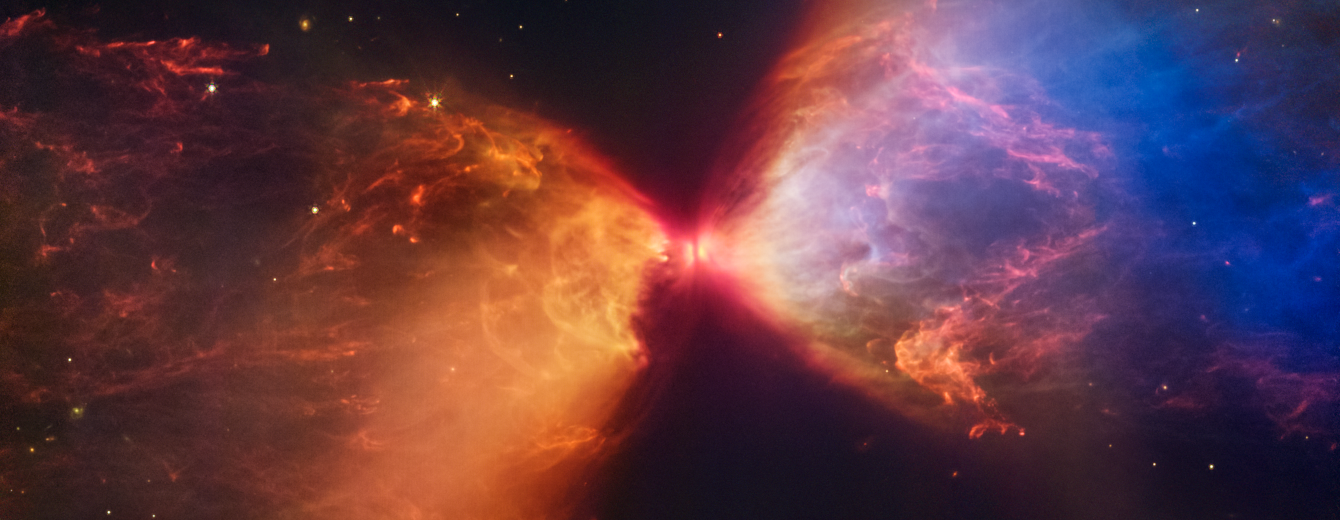NASA’s Webb Catches Fiery Hourglass as New Star Forms
The region’s most prevalent features, the clouds colored blue and orange in this representative-color infrared image, outline cavities created as material shoots away from the protostar and collides with surrounding matter. The colors themselves are due to layers of dust between Webb and the clouds. The blue areas are where the dust is thinnest. The thicker the layer of dust, the less blue light is able to escape, creating pockets of orange.
该区域最普遍的特征是,在这张代表性的彩色红外图像中,蓝色和橙色的云勾勒出了物质从原恒星射出并与周围物质碰撞时产生的空洞。颜色本身是由于韦伯和云层之间的尘埃层。蓝色区域是尘埃最稀薄的地方。尘埃层越厚,蓝光能逃脱的就越少,形成橙色的口袋。
Webb also reveals filaments of molecular hydrogen that have been shocked as the protostar ejects material away from it. Shocks and turbulence inhibit the formation of new stars, which would otherwise form all throughout the cloud. As a result, the protostar dominates the space, taking much of the material for itself.
韦伯还揭示了氢分子的细丝,它们在原恒星喷出物质时受到了冲击。激波和湍流抑制了新恒星的形成,否则它们将在整个云团中形成。因此,原恒星主宰了宇宙空间,为自己占据了大部分物质。
Despite the chaos that L1527 causes, it’s only about 100,000 years old – a relatively young body. Given its age and its brightness in far-infrared light as observed by missions like the Infrared Astronomical Satellite, L1527 is considered a class 0 protostar, the earliest stage of star formation. Protostars like these, which are still cocooned in a dark cloud of dust and gas, have a long way to go before they become full-fledged stars. L1527 doesn’t generate its own energy through nuclear fusion of hydrogen yet, an essential characteristic of stars. Its shape, while mostly spherical, is also unstable, taking the form of a small, hot, and puffy clump of gas somewhere between 20 and 40% the mass of our Sun.
尽管L1527造成了混乱,但它只有大约10万年的历史——一个相对年轻的天体。考虑到它的年龄和红外天文卫星等任务所观测到的远红外亮度,L1527被认为是一颗0级原恒星,是恒星形成的最早阶段。像这样的原恒星,仍然被包裹在尘埃和气体的黑暗云中,在成为成熟的恒星之前还有很长的路要走。L1527还没有通过氢的核聚变产生自己的能量,这是恒星的一个基本特征。它的形状虽然大部分是球形的,但也不稳定,它的形状是一个小的、热的、膨胀的气体团,质量在太阳的20%到40%之间。
As the protostar continues to gather mass, its core gradually compresses and gets closer to stable nuclear fusion. The scene shown in this image reveals L1527 doing just that. The surrounding molecular cloud is made up of dense dust and gas being drawn to the center, where the protostar resides. As the material falls in, it spirals around the center. This creates a dense disk of material, known as an accretion disk, which feeds material to the protostar. As it gains more mass and compresses further, the temperature of its core will rise, eventually reaching the threshold for nuclear fusion to begin.
随着原恒星不断聚集质量,其核心逐渐压缩,并接近稳定的核聚变。这幅图中所示的场景揭示了L1527正是这样做的。周围的分子云是由被吸引到原恒星所在中心的稠密尘埃和气体组成的。当物质下落时,它会绕中心旋转。这就产生了一个致密的物质盘,被称为吸积盘,它为原恒星提供物质。随着它获得更多的质量并进一步压缩,其核心的温度将上升,最终达到核聚变开始的阈值。
The disk, seen in the image as a dark band in front of the bright center, is about the size of our solar system. Given the density, it’s not unusual for much of this material to clump together – the beginnings of planets. Ultimately, this view of L1527 provides a window into what our Sun and solar system looked like in their infancy.
在图像中,这个圆盘在明亮中心的前面是一条暗带,大约和我们的太阳系一样大。考虑到密度,大部分物质聚集在一起并不罕见——这是行星的起源。最终,L1527的图像为我们提供了一扇窗口,让我们了解太阳和太阳系在婴儿期的样子。
Read more at Nasa.gov
NASA官网会为您提供更多信息











